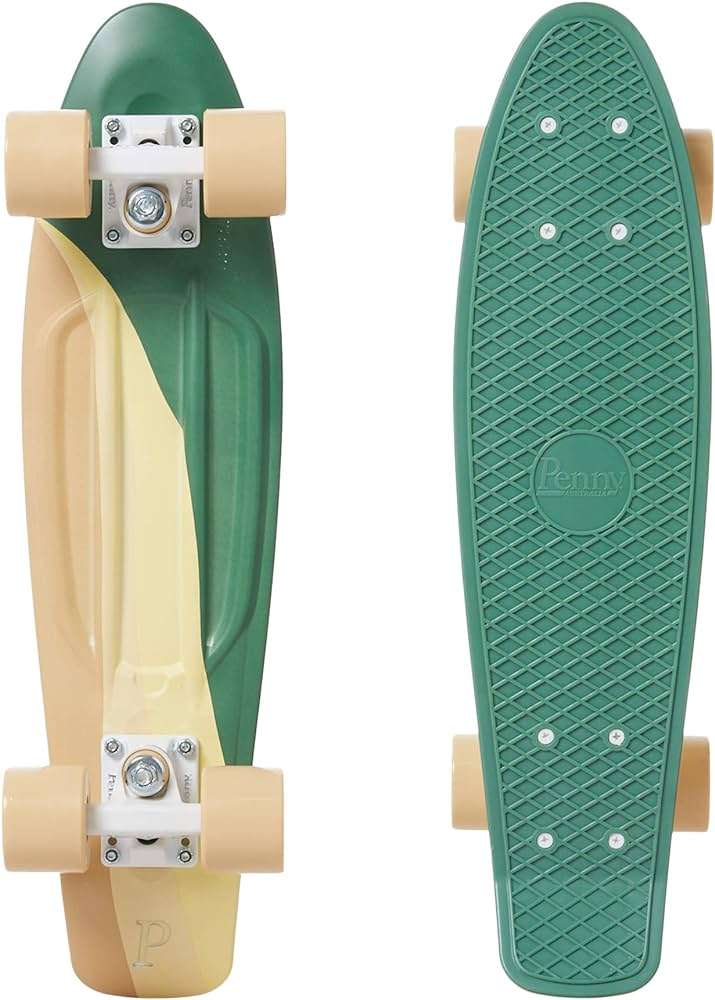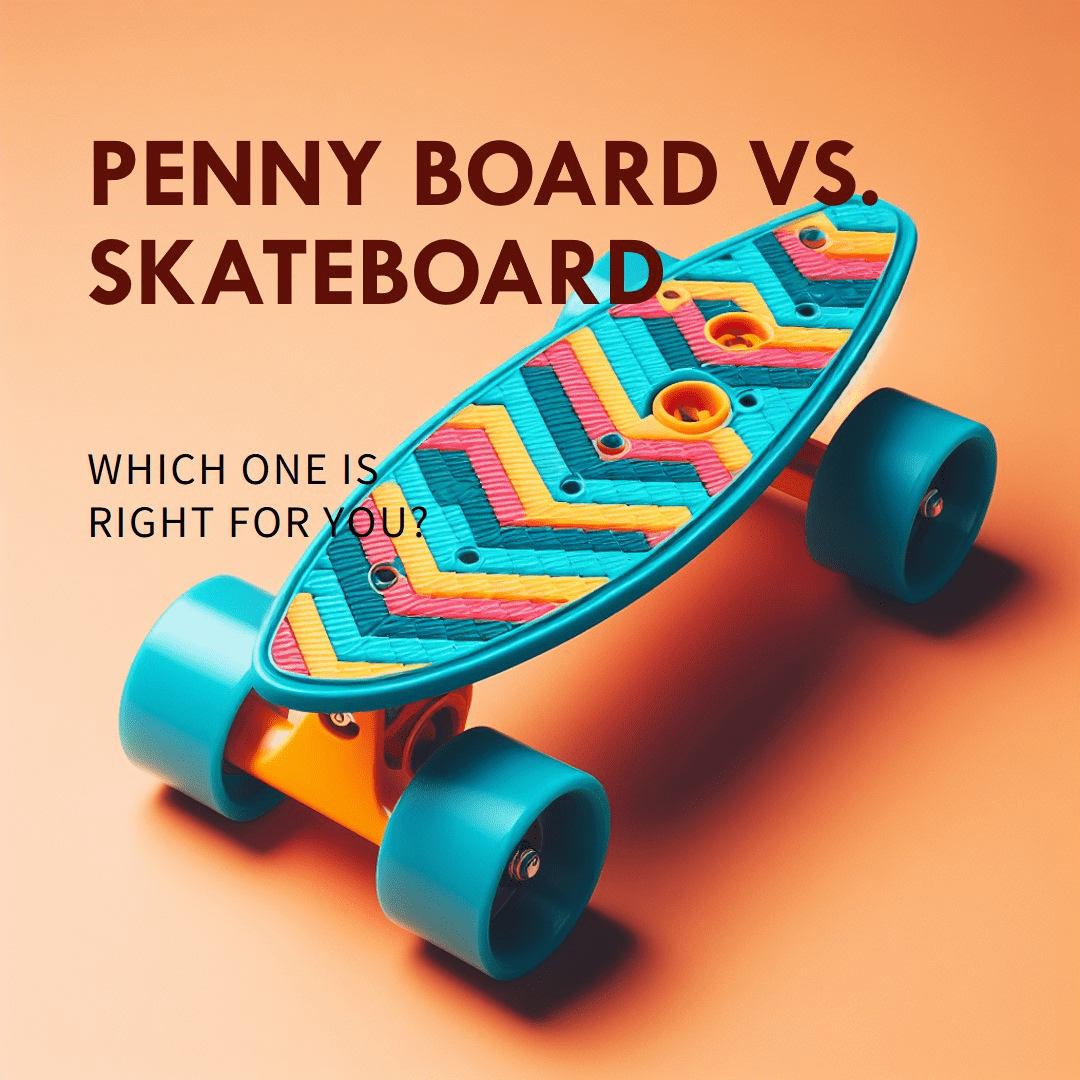Lifemaster Kids Scooter – Children and Toddler 3 Wheel Kick Scooter – LED Wheel Lights Illuminate When Rolling– Adjustable Handlebar – Indoor and Outdoor
12% OffSkateboards and pennyboards are both iconic modes of transportation that are admired for their maneuverability and coolness. However, which is superior to the other? This guide is about to penny board vs skateboard in terms of maneuverability, stunts, and portability, among other critical attributes.
Examine the advantages and disadvantages of each excursion in order to ascertain its suitability for your needs.
Penny Board Overview
In dimensions of 22 by 6 inches, pennyboards are diminutive plastic sailboats. Weighing under 3 pounds, they have a waffle-patterned deck top for grip. Pennyboards are propelled by lightweight trucks and soft 59mm rims.

Pros
- Very portable and lightweight
- Easy to maneuver
- Fun cruising and carving
- Smooth ride on rough surfaces
- Good stability thanks to low center of gravity
Cons
- Limited trick capabilities
- Less grip and power than standard skateboards
- Small deck not ideal for large feet
- Can be slippery in wet weather
- More vibrating than a standard skateboard
Skateboard Overview
Skateboards generally possess wooden surfaces measuring 30-33 inches in length and 7.5-8.5 inches in width. The wheels, which vary from 50-60mm, are mounted on sturdier trucks engineered for tricks. Skateboards weigh 4-8 pounds.

Pros
- Ideal for performing tricks
- A wide deck provides more foot space
- Highly customizable and modifiable
- Very durable for handling impacts
- Provides more speed and power
Cons
- Heavier and less portable than penny boards
- Requires more skill and practice to ride
- Not great at handling rough terrain
- Higher risk of injury due to tricks
Riding Style Penny Board vs Skateboard
A fundamental distinction between penny board vs skateboard is riding technique.
Penny Boards
Pennyboards are designed for cruising and carving. With their nimble trucks, narrow turning radius, and grippy wheels, are exceptionally well-suited for maneuvering through congested areas and effortlessly carving back and forth.
Pennyboards aren’t built for high speeds or downhill riding. Their small size and soft wheels don’t provide enough stability or speed control for those kinds of rides.
Skateboards
Skateboards flourish at velocity, particularly when descending hills. Their stiff decks and wheels grip the pavement well when gaining momentum, allowing skilled riders to reach 20+ mph.
Standard popsicle-shaped skateboards are also engineered for performing tricks. Their wider decks, thicker construction, and mountings provide ideal leverage and durability for ollies, kickflips, grinds, and complex aerials.
As modes of conveyance, skateboards are most effective in wide open spaces where they can sustain velocity, as opposed to the tight turns that penny boards excel at.
Trick Capabilities Comparison
Penny board vs skateboard when it comes to performing stunts.
Penny Boards
Plastic composition and diminutive size severely restrict the types of maneuvers that can be performed. Occasional flips and basic ollies are achievable, but they offer little lift and aerial time.
Landing more advanced tricks like heelflips or 360s would easily snap a penny board’s plastic deck. The soft, short wheelbase also makes tricks very unstable compared to a skateboard.
Beyond the most fundamental ollies and manuals, boards are not primarily intended for trick execution. Riders looking to take their trick skills to the next level need a proper skateboard.
Skateboards
In contrast, skateboards are engineered specifically for tricks. Their wider decks and longer wheelbases provide the ideal leverage, stability, and durability. Consistently achieving ollies several feet in the air enables skateboard riders to perform intricate flip, catch, and rotation maneuvers.
Skateboards are built to withstand the impact of high aerials and board slides as well. Quality decks can endure hours of daily trick attempts without warping or breaking.
To advance and safely execute stick landings, skaters interested in performing feats beyond the fundamentals require a skateboard deck. Their boards offer the right balance of flexibility, control, and impact resistance.
Portability Comparison
Penny board vs Skateboard : One area where penny boards stand out is portability:
Penny Boards
Penny are immaculately portable, weighing less than 3 pounds and measuring a mere 22 inches in length. Their light plastic construction makes them one of the most portable rideables available.
Penny boards can be conveniently tucked under an arm, stored in a backpack or locker, and taken anywhere without hassle. For portable transport and stowing away, penny boards can’t be beat.
Skateboards
Skateboards, on the other hand, are substantially longer and weigh several pounds more. Their bulkier size and weight make skateboards much more difficult to carry around.
When transporting skateboards, riders are frequently required to awkwardly grasp them under their arms or carry them by hand. In order to store skateboards out of the way, a sizable area or a distinct transporting case is necessary.
Pennyboards have a significant advantage over standard skateboards in terms of portability and stowage capacity. Penny boards are capable of traversing areas that skateboards are unable to due to their compact size.
Durability Comparison
In terms of longevity, skateboards establish a definitive advantage:
Penny Boards
Penny boards fracture, dent, and break considerably more readily than wooden skateboard decks due to their lightweight plastic construction. Grating on rails and ledges also accelerates the removal of their plastic.
Pennyboards utilize cheaper components as well. From wheels to bearings to trucks, the parts degrade faster compared to standard skateboard parts. Serious penny boarding can require replacing parts every few months.
Penny boards, despite their affordability and portability, compromise a substantial amount of durability, which is critical for common skateboarding. Compared to a high-quality wooden skateboard, their overall lifespan is negligible.
Skateboards
Good skateboard decks are constructed from 7-9 plies of hardwood maple. Due to the layered timber construction, skateboard decks are exceptionally resistant to pressure scratches, snapping, and impacts.
Skateboard wheels, trucks, and bearings also utilize higher quality components designed to withstand daily abuse. Brand name wheels have ultra-high rebound urethane that maintains its shape. Grade 5-8 steel axles and bearings stand up to hardcore trick sessions.
Skateboarders can utilize a single, dependable deck for considerable durations of time prior to its eventual replacement. Skateboards are initially more expensive, but ultimately more durable.
Customization Comparison
Penny board vs Skateboard : Another skateboard strength is customizability:
Penny Boards
The possibilities for modifying or personalizing cent boards are exceedingly restricted. Their compact plastic deck shape does not allow for switching parts or upgrading components.
Riders are limited to choosing different colored boards and wheels. Things like deck shape, wheel durometer, truck height, and bearing quality cannot be adjusted. The rider’s capacity to personalize the ride experience and aesthetic is significantly restricted.
Skateboards
In contrast, standard skateboards are almost entirely customizable. Their layered wood construction allows for fully custom decks in endless shapes and graphical styles.
Every component on a skateboard can also be swapped for aftermarket parts. Wheels, trucks, bearings, bushings, and hardware have limitless combinations to customize responsiveness, turning, and ride style.
Skateboards offer infinite possibilities for riders seeking a board that corresponds to their personal style and customization preferences. Penny board customization simply cannot compare.
Cost Comparison
Penny board vs Skateboard : The price of pennyboards is a significant advantage over skateboards.
Penny Boards
A complete penny board costs $80-$120 typically. Fabrication expenses are significantly reduced due to their mass production utilizing inexpensive components and basic forms.
Even high-end penny boards with upgraded wheels or ceramic bearings cost well under $200 fully assembled. Because of this, penny boards are the most economical option for skates.
Skateboards
Complete skateboards start around $100 for lower quality boards. The average price for a good complete is $150-$220 for name-brand components and deck.
Building a custom skateboard can also cost $300+, especially with top-tier trucks, wheels, bearings, and multiple decks. Most skaters view this premium as worth it for better parts.
Pennyboards are undoubtedly the more affordable way to start riding. Skateboards do cost significantly more but provide a higher ceiling for customization and performance.
Safety Considerations
Both penny boarding and skateboarding come with inherent injury risks, but skateboarding has more hazards to consider:
Penny Boards
The limited tricks and lower speeds of penny boarding make them a bit safer than skateboards in general. Still, new riders should wear helmets to avoid cracking skulls. Wrist guards also help prevent fractures.
Remaining aware of traffic and road debris is critical too. Sudden cracks or getting hit by a car pose threats. Avoiding water and other slick surfaces mitigates slip risks.
Overall, penny-boarding risks involve mostly slips and falls. Their limited maneuverability provides less opportunity for catastrophic crashes compared to skateboards.
Skateboards
With skateboarding, attempts at complex tricks, high speeds, and elevated landings create greater risks. Wearing pads, helmets, and slide gloves should be mandatory.
Checking skateparks and terrain thoroughly before attempting tricks is also key. Rogue debris or wet patches can mean the difference between landing clean or slamming hard.
Skateboarding’s learning curve also causes many beginner injuries. Mastering the board control needed for tricks or downhill takes time and practice. Rushing the process often results in crashes.
While inherently riskier, caution and safety gear greatly mitigate skateboarding’s dangers. But complacency on a skateboard finds even experts injured. Respect for the board and one’s limits are critical.
Which is Better for Beginners?
For first-timers, penny boards provide the most gentle learning curve:
- Softer wheels grip pavement and dampen vibration
- A lower center of gravity enhances stability
- Limited speed reduces catastrophic crashes
- Turning doesn’t require muscling the board
- Compact size enables quick bail-outs
Pennyboarding allows beginners to comfortably cruise around and focus on balance. Basic steering and pushing come intuitively without as much practice required.
Skateboarding takes much longer to feel natural and requires developing board control. But skateboarding skills scale higher, enabling tricks penny boards can never achieve.
Ultimately the preferred option comes down to riding goals. Pennyboards enable casual cruising quickly, while skateboarding is worth the investment for mastering techniques.
Frequently Asked Questions
Are penny boards good for tricks?
No, penny boards are very limited when it comes to tricks. Their plastic decks can’t withstand impact well and their soft wheels provide little pop. Only basic ollies and manuals are feasible. Anyone serious about trick skating needs a proper wooden skateboard.
At what age is a penny board too small?
The compact 22-inch deck can feel too small for adult feet size 10 and up. Kids’ feet often fit penny boards better. Tall teens around 5′ 8″ and taller may also feel too large and awkward on a penny board.
Are penny boards good for commuting?
Yes, penny boards are great commuting options for shorter urban rides. Their tight turning radius allows weaving through pedestrians easily. The compact size is perfect for stashing under desks or in lockers once at school or the office.
Can penny boards go fast?
Not as fast as a typical skateboard. Small plastic wheels only allow penny boards to reach moderate speeds around 10-15 mph comfortably. They lack the stability and traction for high speeds that wider longboards and skateboards provide.
Should a beginner start on a penny board or skateboard?
For an absolute beginner, a penny board is recommended. Their intuitive steering, soft wheels, and low speeds make balancing and pushing off much easier initially. Skateboards require more coordination and practice before riding comfortably.

I’m the founder of HoverboardsGuide.com, a comprehensive website dedicated to electric scooters and hoverboards. With a deep-rooted passion for electric gadgets, I’ve accumulated extensive experience in this field. I aim to assist users in selecting the best gadgets and providing reliable guidance.
I’ve tested and reviewed numerous models, gaining in-depth knowledge about their features, performance, and overall quality. Feel free to reach out to me with any queries, as I’m dedicated to addressing your concerns promptly. Join me on this exciting journey of exploring the world of electric rides and making informed decisions













